Because of the peculiar construction resulting from their complex history, our brains are far from directly comparable to a feat of human engineering. Indeed, they are probably not comparable at all. For engineers always strive, even where they are consciously or unconsciously constrained, for optimal solutions to the problems they are facing. In contrast, during the long and untidy process that gave rise to the modern human brain, what was already there was always vastly more influential on the historical outcome—what actually did happen—than any potential for future efficiencies could be. And thank goodness for that. After all, if our brains had been designed like machines, if they had been optimized for any particular task, they would be machines, with all of the predictability and tedious soullessness that this would imply. For all their flaws, it is the very messiness and adventitiousness of our brains that makes them—and us—the intellectually fertile, creative, emotional, and interesting entities that they and we are.
No matter how dissimilar they may now appear to the eye, all life forms are ultimately linked at the genomic level to a single common ancestor that lived more than 3.5 billion years ago.
History severely limits what you can potentially become not simply because you must necessarily be a version of what went before, but because genomes, dedicated as they are to the propagation of mind-bogglingly complex systems, turn out to be hugely resistant to change. In fact, they provide the ultimate example of “if it ain’t broke, don’t fix it.” After all, fiddling around with anything as intricate as a genome is asking for trouble: most random changes to a functioning system this complicated simply won’t succeed. The fact that changes in the genetic code carry huge risks explains the inherent conservatism of genomes. It also explains why some organisms that look hugely different to the eye have amazingly similar genes: I’ve heard it said that we share over 40 percent of our genes with a banana, while a gene that is highly active in determining human skin color is also responsible for regulating the dark stripes on the side of a zebrafish.
One reason why human females tend to run more slowly than males is the greater average width of their hips.
A major imponderable in paleoanthropology is how the early hominids contrived to cope with a new diet that evidently included animal fats and proteins. Even today, we meat-eating humans have digestive tracts that more closely resemble those of our vegetarian ancestors than they do those of carnivores. And our teeth, small as they have become, are essentially those of plant-eaters, emphasizing grinding rather than carnivorous cutting. But at some point those ancient vegetarian bipedal apes became interested in animal carcasses: an interest based on the potential of those cadavers to provide food. Dealing with this unfamiliar dietary supplement posed a host of problems.
Still, some authorities think that the increase in average hominid brain size that began some two million years ago could only have been made possible by higher-quality (i.e., higher-fat, higher-protein) diets than plant materials alone could have supplied.
Throwing seems like a natural thing to us today, and indeed such sports as baseball depend on it; but in reality it’s another of our unusual qualities. Today we are the only precision thrower out there. A camel may be able to spit in your eye, but for all the strength in their arms, chimpanzees can’t throw a rock very far or hope to hit anything much smaller than a barn door with it. They may have a fearsome feces-flinging reputation among zoo-goers; but they don’t have the projectile abilities you’d want to depend on in a life-and-death situation.
But if you crammed four hundred chimpanzees into the back of an airplane and flew them from New York to Tokyo, there’s little doubt that on arrival you’d find that the chimps had all massacred each other. Chimpanzees are highly social beings by any standard, but they do not have the special kind of sociality that it takes to live in a world as packed with people as ours is today.
No surprise, then, that these monkeys are also quite vocal. Often the groups forage and move around in such a way as to keep the reproducing females and young in the physical center, while the more expendable young males remain at the vulnerable periphery, where they can also function as sentinels
Hart and Sussman thus reasonably conclude that the very early hominids would have had the social characteristics not of hunters, but of prey species. Our ancestors were the hunted, not the hunters; and these authors believe that much in our modern behavior still reflects this.
Since Gallup’s pioneering study, the “mirror test” has become the standard yardstick for self-recognition among vertebrates, and a wide variety of species has been tested. Human beings naturally need to learn mirror self-recognition (MSR) just as the chimpanzees did; but adults to whom sight has been restored do so quickly, and most human infants can manage the trick at 18 to 20 months of age. Young apes develop more rapidly than human children in many respects, but studies building on Gallup’s original have shown that MSR is rare among chimpanzees under eight years old: it is basically an adult ability. By now, MSR has been demonstrated not only in chimpanzees but also in bonobos, orangutans, and gorillas, although not all tested individuals of these species have shown it. Outside the human–great ape group MSR is evidently extremely rare among vertebrates (though elephants, dolphins, and certain birds may display it); and to the extent it occurs, different underlying mechanisms are almost certainly at work than those operating in great apes and humans.
In Seyfarth and Cheney’s words, they “do not know what they know, cannot reflect on what they know, and cannot become the object of their own attention.”
One of our most striking characteristics—almost as striking as our large brains—is that we have remarkably small internal organs for our body size. This was also true for the relatively narrow-hipped Homo ergaster, and it has important implications for the diet of the Turkana Boy and his fellows. For the internal organs are almost as “expensive” in energetic terms as the brain; and it has been powerfully argued that gut reduction in human evolution has not only been a necessary trade-off for brain expansion, but that at the same time it also exacerbated the need for a high-quality diet.
Though faster than humans, most mammals do not have the capacity to shed the heat load acquired and generated during sustained activity in the tropic sun, except by pausing in the shade while it slowly dissipates, largely through panting. Hairless humans, on the other hand, constantly shed heat by sweating and radiation, allowing them to keep going when other animals drop from heatstroke.
Most kinds of mammal only support one louse species; but humans have the luxury of sustaining two. One of these parasites lives in the hair of the head; the other inhabits the hair of the pubic region. A bit embarrassingly, while the human head louse is distinctive, the human pubic louse is a close relative of the form that inhabits gorillas, and is thought to have been acquired from this source. The head louse seems to be a survivor of the form that roamed all over the body of the human ancestor, while the pubic louse was acquired subsequent to the loss of body hair.
it’s no coincidence that the highest skin cancer rates in the world today occur in Australia’s sunny Queensland, where fair-skinned folk are wont to unwisely disport themselves in minimal clothing.
To put this at its most elementary, humans care at least to some extent about each other’s welfare; and chimpanzees—as well as probably all of our other primate relatives—do not. Of course, mother-offspring bonds among chimpanzees can last a lifetime; and hunting and similarly complex activities sometimes involve extensive coordination among group members. What’s more, chimpanzees have been observed to console victims of aggression, suggesting that they have some form of individual empathy. But such manifestations are different from the general concern for others that underwrites prosociality; and, in a large body of experimental studies, chimpanzees have come across—even to chimpophile researchers—as creatures that show a striking lack of regard for their fellows.
This is totally consistent with the fact that, from the beginning, hominids have always been ecological generalists. We have typically avoided the dangers of specialization by remaining unfailingly flexible in our responses to changing external conditions, in a sometimes dramatically fluctuating world. Hominids typically haven’t so much adapted to change, as they have accommodated to it.
Nonetheless, there is one important observation that suggests that members of the genus Homo have been consistently predisposed in some way toward brain size increase: brain enlargement has occurred independently in at least three lineages within the genus. The earliest Homo erectus in Java, dating from perhaps more than 1.5 million to a bit under one million years ago, have brains ranging from around 800 cc to a bit over 1,000 cc in volume. A later Javan group, poorly dated but maybe about a quarter of a million years old, comes in at 917 cc to 1035 cc; and the latest Javan Homo erectus group of all, perhaps no more than 40 thousand years old, varies from 1,013 cc to 1,251 cc. Similarly, Homo sapiens and Homo neanderthalensis diverged from a smaller-brained common ancestor well over half a million years ago, and independently gained their comparably sized large brains. Thus, a 600-thousand-year-old collection of Spanish fossils foreshadowing the Neanderthals had brains some 1,125 cc to 1,390 cc in volume, against the later Neanderthal average of 1,487 cc.
This trend received a huge impetus about three million years ago, when the collision of North with South America produced the Isthmus of Panama. The new land barrier blocked the circulation into the Atlantic Ocean of warm Pacific water, producing an acceleration of the cooling and drying trend in Africa, and initiating the formation of an ice cap in the Arctic. We see the results of this event dramatically expressed in the African fossil record beginning around 2.6 million years ago, with a proliferation of grassland-adapted grazing mammals and the disappearance of older browsing forms. Some authorities believe that the environmental shift reflected in faunal change around this time was the most significant stimulus to the emergence of our genus Homo; and whether or not this was actually the case, it is certainly true that the underlying event ushered in a new climatic cycle that exerted a profound influence on later phases of hominid evolution.
It’s worth noting, though, that by regularly fragmenting already sparse hominid populations both in Africa and Eurasia, the Pleistocene offered ideal conditions for the local fixation of genetic novelties and for speciation.
The latest official geological determination (with which not everyone is happy) is that the start of the glacial cycle around 2.6 million years ago marks the beginning of what geologists call the Pleistocene (“most recent”) epoch, which runs right up to the last major ice cap retreat about 12 thousand years ago. The time since is known to geologists as the Holocene (“entirely recent”) epoch—although, human impact apart, there is no good reason for thinking we are out of the glacial cycle.
The initiation of the Arctic ice cap at around 2.6 million years ago marked the beginning of the “Ice Ages” cycle of alternating glacial and interglacial episodes, as the ice caps at both ends of the Earth regularly expanded and contracted. These fluctuations occurred because of differences in solar radiation received at the planet’s surface due to variations in its orbit around the Sun.
By about a million years ago, when vast Serengeti-style savannas were becoming established in parts of Africa, this cycle had settled down into a fairly steady rhythm, swinging every hundred thousand years or so from cold troughs to warm peaks (of the kind we are experiencing today). Between the extremes, numerous shorter-term oscillations occurred. Sometimes those oscillations were very short-term indeed, rather like the “Little Ice Age”—which itself showed three distinct temperature minima—that spanned the sixteenth to nineteenth centuries.
For there can be no doubt that the evolutionary history of hominids during this epoch was hugely more eventful than that of any comparable group of mammals of the period. We differ today far more from our earliest Pleistocene ancestors than do any other of the creatures with which we share the planet.
Like Homo sapiens today, Homo neanderthalensis was an opportunistic omnivore, reminding us that despite our secondary adoption of a predatory lifestyle, we have never entirely put behind us our ancient vegetarian heritage.
When Neanderthals and Cro-Magnons met on the landscape it seems probable that, for all their similarities, they would have perceived each other as alien beings, each with its own way of viewing and dealing with the world. Language would have been a major issue, among many others. Whereas the Cro-Magnons almost certainly possessed language as we know it today—however different their specific language might have been from any spoken now, or even within recorded history—it seems likely that the Neanderthals did not.
When we ponder the differences between the Cro-Magnons—whose lives, like ours, were doubtless riddled with myth and superstition—and the Neanderthals, perhaps the closest thing we can obtain to a glimpse of the divergence in psyche comes from the grisly yet matter-of-fact fate of the hapless denizens of El Sidrón, and from the casual way in which that piece of skull bone from La Quina was used as the most inconsequential type of tool. I cannot help but read an intense form of focused practicality—and a related lack of symbolic imagination—into these and all the other material leavings of the Neanderthals. These large-brained relatives certainly were smart; but their particular kind of smartness was not ours. This difference is hard for us to comprehend fully.
In striking contrast, once behaviorally modern humans had emerged from Africa the world rapidly became a hominid monoculture. This is surely telling us something very important about ourselves: thoughtlessly or otherwise, we are not only entirely intolerant of competition, but uniquely equipped to express and impose that intolerance. It’s something we might do well to bear in mind as we continue energetically persecuting our closest surviving relatives into extinction.
I’ve already briefly mentioned the classic example of feathers, which were possessed by the ancestors of birds many millions of years before these modified dermal follicles were ever recruited as essential components of the flight mechanism.
It is hard to tell just what the actual context might have been, especially since a small, retracted face comes with some significant disadvantages. For one, it reduces the length of the tooth-rows, crowding the teeth and frequently leading to impactions and malocclusions; for another, lowering the larynx involves a crossing of the airways with the food tract that introduces a severe danger of choking—something that is much less likely when the larynx is high. This effect is more than an inconvenience; in Japan alone, famous for its bite-sized foods, more than 4,000 people choke to death every year.
Many scientists have accordingly used the differentiation of languages as a guide to the spread of mankind across the globe. And in doing this they have traditionally concentrated on the words that make up those languages. But this has proved a tricky endeavor, for individual words change quite rapidly over time: so rapidly that beyond a time depth of about five thousand years, or ten at the very most, it turns out to be fairly hopeless to look for substantial traces of relationship. As a result, while language has indeed proven useful in tracing the movement of peoples around the Earth over the last few thousand years, linguists have been somewhat stymied when it comes to its very early evolution.
The New Zealand cognitive psychologist Quentin Atkinson has recently suggested an alternative. According to Atkinson, in seeking the origins of language we are better off looking not at words as a whole, but at the individual sound components—the phonemes—of which they are comprised. This makes sense, because the phonemes are much more bound by biology than are the ideas that their combinations represent. And when Atkinson looked at the distribution of phonemes in languages around the world, he found a remarkable pattern. The farther away from Africa you go, the fewer phonemes are typically used in producing words. Some of the very ancient “click” languages of Africa, spoken by people with very deep genetic roots, have over a hundred phonemes. Our English language has about 45; and in Hawaii, one of the last places on Earth to be colonized by people, there are only 13.
Atkinson’s analysis suggests that the convergence point may be in southwestern Africa, which is also in line with one recent genetic study. And his results imply not only that modern Homo sapiens originated in a single place, but also that the same thing was true for language (or at least, for the form of language that survives today). In which case, there is a strong argument for a fundamental synergy between biology and language in the rapid takeover of the world by articulate modern people.









